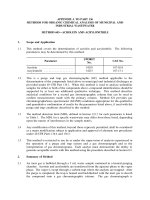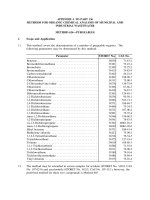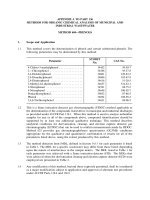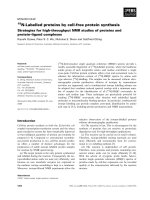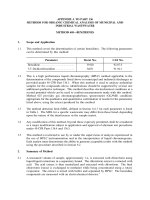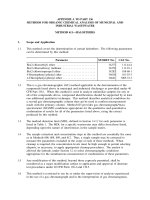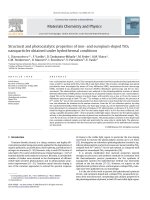Quantum chemical studies of niobium and vanadium doped gold clusters
Bạn đang xem bản rút gọn của tài liệu. Xem và tải ngay bản đầy đủ của tài liệu tại đây (6.99 MB, 188 trang )
Doctoraatsproefschrift aan de Faculteit Wetenschappen van de KU Leuven
Quantum Chemical Studies of Niobium
and Vanadium-doped Gold Clusters
PHAM VU NHAT
Promotor:
Prof. Minh Tho Nguyen
Members of the Jury:
Prof. Luc Van Meervelt
Prof. Marc Hendrickx
Prof. Tatjana Vogt
Prof. Frank De Proft
Prof. Ewald Janssens
Dissertation presented in partial
fulfilment of the requirements for
the degree of Doctor of Science
in Chemistry
December 2012
© 2012 Faculteit Wetenschappen, Geel Huis, Arenberg Doctoraatsschool, Kasteelpark
Arenberg 11, B-3001 Heverlee, België
Alle rechten voorbehouden. Niets uit deze uitgave mag worden vermenigvuldigd en/of
openbaar gemaakt worden door middel van druk, fotokopie, microfilm, elektronisch of
op welke andere wijze ook zonder voorafgaandelijke schriftelijke toestemming van de
uitgever.
All rights reserved. No part of the publication may be reproduced in any form by print,
photoprint, microfilm, electronic or any other means without written permission from
the publisher.
ISBN 978-90-8649-576-4
D/2012/10.705/93
to my parents, my wife, and my daughter
Buồn trông phong cảnh quê người,
đầu cành quyên nhặt, cuối trời nhạn thưa.
Strange landscapes met the mournful eyes,
on trees cuckoos galore, at heaven's edge some geese.
Kieu Story, Nguyen Du
i
ii
Members of the Jury
Prof. Dr. Luc Van Meervelt (Chair)
Department of Chemistry, KU Leuven
Prof. Dr. Marc Hendrickx
Department of Chemistry, KU Leuven
Prof. Dr. Tatjana Vogt
Department of Chemistry, KU Leuven
Prof. Dr. Frank De Proft
Faculty of Sciences, Vrije Universiteit Brussel (VUB)
Prof. Dr. Ewald Janssens
Department of Physics and Astronomy, KU Leuven
Prof. Dr. Minh Tho Nguyen (Promoter)
Department of Chemistry, KU Leuven
iii
iv
Acknowledgments
This work has been carried out during the period of January 2009 –
December 2012 at the Department of Chemistry, University of Leuven, Belgium. My
journey to this point turned out to be much less difficult than I expected as it has
been accompanied and supported by many people. Now is a pleasant opportunity
to express my gratitude for all of them.
First and foremost, I would like to thank my supervisor Prof. Minh Tho
Nguyen for his endless patience and enthusiasm, along with his understanding and
motivating guidance during my Ph.D. studies. I have really been fortunate that I
have come to know him in my life.
I also would like to send special thanks to Prof. Arnout Ceulemans, Prof.
Marc Hendrickx, Prof. Paul Geerlings (VUB) and Prof. Frank De Proft (VUB). I did
benefit much from their excellent knowledge and teaching on quantum chemistry.
Besides, I am grateful to all members of the Jury for their valuable comments,
suggestions and corrections that greatly enrich my work. I in addition appreciate
the timely helps from Mrs. Rita Jungbluth and Dr. Hans Vansweevelt. I always got
the right answers whenever knocking their doors. I thank also Prof. Marc
Hendrickx and Drs. Pieter Kelchtermans for the translation of the “Samenvatting”.
I am also indebted to Profs. Peter Lievens and Ewald Janssens for valuable
discussion on clusters, Dr. Andre Fielicke from the Fritz-Haber Institute in Berlin,
Germany, for providing me the original plots of his experimental IR spectra on Nb
clusters, and Prof. Jerzy Leszczynski for his support during my visit to the Jackson
State University, Mississippi, USA.
Financial support from the KU Leuven Research Council and the Can Tho
University is gratefully acknowledged.
How sad and tough would it be to live far from the family and home
without friends. Thus, I am truly thankful to all my colleagues in the Division of
Quantum Chemistry for the friendly working atmosphere, and to all my Vietnamese
friends in Leuven for the numerous nice non-scientific meetings.
Finally, the greatest thanks go to my parents, my wife and my daughter.
They stand beside me all the time and bring the sunshine to me in the most difficult
moments. I dedicate this thesis to them.
v
vi
This thesis is based on the following publications:
1) A New Look at the Structure and Vibrational Spectra of Small Niobium Clusters
and Their Ions.
Pham Vu Nhat, Vu Thi Ngan and Minh Tho Nguyen, J. Phys. Chem. C, 2010, 114,
13210–13218.
2) Electronic Structures, Vibrational and Thermochemical Properties of Neutral and
Charged Niobium Clusters Nbn, n = 7−12.
Pham Vu Nhat, Vu Thi Ngan, Truong Ba Tai, and Minh Tho Nguyen, J. Phys. Chem.
A, 2011, 115, 3523–3535.
3) Reply to “Comment on „Electronic Structures, Vibrational and Thermochemical
Properties of Neutral and Charged Niobium Clusters Nb n, n = 7–12.‟”
Pham Vu Nhat, Vu Thi Ngan, Truong Ba Tai, and Minh Tho Nguyen, J. Phys. Chem.
A, 2011, 115, 14127–14128.
4) Structures, Spectra, and Energies of Niobium Clusters from Nb 13 to Nb20.
Pham Vu Nhat and Minh Tho Nguyen, J. Phys. Chem. A, 2012, 116, 7405–7418.
5) Trends in Structural, Electronic and Energetic Properties of Bimetallic Vanadium–
gold Clusters AunV with n = 1–14.
Pham Vu Nhat and Minh Tho Nguyen, Phys. Chem. Chem. Phys., 2011, 13, 16254–
16264.
6) Theoretical Study of AunV-CO, n = 1 – 14: The Dopant Vanadium Enhances CO
Adsorption on Gold Clusters
Pham Vu Nhat, Truong Ba Tai and Minh Tho Nguyen, J. Chem. Phys., 2012, 137,
164312–164324.
7) The Icosahedral Evolution in Bimetallic Clusters AunV, with n = 12 – 20.
Pham Vu Nhat and Minh Tho Nguyen, J. Chem. Phys., 2012, (submitted).
vii
8) Structural Evolution, Vibrational Signatures and Energetics of Small Niobium
Clusters.
Pham Vu Nhat and Minh Tho Nguyen, Coord. Chem. Rev., 2012, (to be submitted).
Other publications:
9) Structure and Stability of Aluminum-doped Lithium Clusters (LinAl0/+, n = 1–8): A
Case of The Phenomenological Shell Model.
Truong Ba Tai, Pham Vu Nhat and Minh Tho Nguyen, Phys. Chem. Chem. Phys.,
2010, 12, 11477–11486.
10) Electronic Structure and Thermochemical Properties of Small Neutral and
Cationic Lithium Clusters and Boron-Doped Lithium Clusters: Lin0/+ and LinB0/+ (n =
1–8).
Truong Ba Tai, Pham Vu Nhat, Minh Tho Nguyen, Shenggang Li, and David A.
Dixon, J. Phys. Chem. A, 2011, 115, 7673–7686.
11) Theoretical Study of Manganese Hydrides and Halides, MnXn with X = H, F, Cl,
Br, n = 1 – 4.
Pham Vu Nhat, Ngo Tuan Cuong, Pham Khac Duy and Minh Tho Nguyen,
Chemical Physics, 2012, 400, 185.
viii
Samenvatting
In dit doctoraatswerk ging onze aandacht uit naar de microscopische details
van metalische clusters, gekenmerkt door een omvang van enkele nanometers, zoals
we die kunnen berekenen met kwantumchemische methoden. We hebben ons
voornamelijk geconcentreerd op de structurele, elektronische en energetische
eigenschappen van twee types van transitiemetallclusters, zoals die een fundamenteel
inzicht kunnen verschaffen in hun technologische toepassingen. Bovendien hebben
we ook het effect van dopering onderzocht op bepaalde eigenschappen van deze
clusters.
De
meeste
berekeningen
werden
uitgevoerd
in
het
kader
van
functionaaldensiteitstheorie met behulp van pseudo-potentiaal basissets. In de
volgende paragrafen geven we aan hoe het doctoraatproefschrift is onderverdeeld in
hoofdstukken.
Hoofdstuk 1 bevat een volledig overzicht van de bestudeerde clusters.
Verder geeft dit hoofdstuk ook het belang weer van de dergelijke nanopartikels vanuit
wetenschappelijk
en
technologisch
standpunt.
Recentelijke
ontwikkelingen
betreffende de studie van transitiemetaalclusters worden eveneens besproken.
Bovendien wordt de aandacht gevestigd op het belang van de d-valentie-elektronen,
de lanthanidecontractie en de relativistische effecten voor de beschrijving van vele
eigenschappen van deze clusters. Dit was onze belangrijkste motivatie om deze
moeilijk te berekenen type van clusters te bestuderen op theoretisch vlak. We kunnen
inderdaad opmerken dat, niettegenstaande er meer en meer experimentele resultaten
beschikbaar komen, de kwantitatieve interpretatie ervan grotendeels ontbreekt.
Hoofdstuk 2 bevat een kritische analyse van de performantie van de huidige
DFT-technieken
en
hun
mogelijke
toepassingen
in
het
domein
van
de
transitiemetaalchemie. Hoewel DFT-berekeningen een onmisbaar instrument zijn
geworden voor de berekening van de elektronische structuren en de daarmee
samenhangende eigenschappen, blijkt toch dat elke functionaal zijn voordelen en
nadelen heeft voor welbepaalde systemen. Deze analyse diende als een eerste en
nuttige leidraad betreffende de keuze van een geschikte functionaal ter berekening
ix
van bepaalde parameters van een specifiek systeem. Tot op zekere hoogte presteren
functionalen met een lage HF-bijdrage gewoonlijk beter dan de standaard
hybridemethoden ter berekening van de moleculaire eigenschappen van clusters die
uitsluitend transitiemetalen bevatten. We moeten echter tot de conclusie komen dat
geen enkele functionaal geschikt is voor alle structurele en energetische parameters.
Daarom is het van cruciaal belang om een zorgvuldige analyse uit te voeren
aangaande de toepasbaarheid van de verschillende computationele opties voor elk
nieuw type van verbinding. Hiertoe wordt een systematische vergelijking gemaakt
van de berekende resultaten met de experimentele gegevens of met hoogwaardige
MO-methoden.
In hoofdstuk 3 onderzoeken we systematisch de structurele evolutie,
vibrationele progressies en energetische eigenschappen van Nbn clusters (n = 2 − 20),
in zowel neutrale als geladen toestand. Verscheidene fundamentele energetische
eigenschappen van clusters, inclusief elektronaffiniteiten, ionisatie-energieën,
bindingsenergie per atoom en stapsgewijze dissociatie-energieën worden berekend en
vergeleken met gemeten waarden. De vibrationele (IR) spectra van systemen kleiner
dan Nb13 werden bestudeerd samen met de waargenomen ver-IR karakteristieken.
Hoewel de experimentele IR-spectra voor grotere clusters tot op heden nog niet
beschikbaar zijn, presenteren we hier voorspellingen die toelaten de voorgestelde
evenwichtsstructuren te verifiëren, van zodra de relevante spectroscopische
informatie beschikbaar komt. Gebaseerd op de theoretische en experimentele
bevindingen vermelden we tot slot een enkele algemene en belangrijke punten
omtrent de bestudeerde Nbn-clusters.
Een ander project van dit proefschrift behelst een uitgebreid onderzoek naar
het groeigedrag, de energetische eigenschappen en CO-affiniteit van vanadiumgedopeerde goudclusters AunV met n = 1 – 20. Hoofdstuk 4 bestudeert in detail hoe
pure goudsystemen beïnvloed worden door het doperingsatoom vanadium. Er valt
duidelijk waar te nemen dat de structurele evolutie en gerelateerde eigenschappen van
goudclusters sterk veranderen door de introductie van een vanadiumatoom. We
vinden dat een dergelijke substitutie in clusters met oneven aantal atomen de
x
thermodynamische stabiliteit aanzienlijk verhoogt, maar deze bij oneven clusters
significant verlaagt. Vrij algemeen wordt CO-adsorptie versterkt na dopering.
Dieper
inzicht in de
elektronische,
geometrische
en energetische
eigenschappen van transitiemetaalclusters zijn erg belangrijk voor de verdere
ontwikkeling van corresponderende nanomaterialen en nanostructuurtechnologieën.
Dit verklaart de noodzaak van een gedetailleerd theoretisch inzicht van zulke
systemen. De resultaten die in deze thesis worden gerapporteerd kunnen dus hun
dienst bewijzen in toekomstige experimentele en theoretische studies betreffende
metaalclusters. Verscheidene vraagstukken blijven echter onopgelost en motiveren
dus verdergaand onderzoek.
Hoewel DFT-methoden ons redelijk wat informatie kunnen verstrekken over
allerlei eigenschappen van de grondtoestand van deze clusters, houden ze nog steeds
een aanzienlijke rekenkost in. Daarom is tot op heden het computationele
studiegebied beperkt tot systemen met een klein aantal atomen, en konden maar
enkele berekeningen naar eigenschappen van geëxciteerde toestanden uitgevoerd
worden. In de komende jaren hopen we op doorbraken in termen van zowel
methodologie als rekencapaciteit waardoor theoretisch onderzoek op grotere clusters
van metalen en halfgeleiders haalbaar en betrouwbaar wordt. We kijken ook uit naar
bijkomende spectroscopische data van verscheidene experimenten die onze
voorspellingen kunnen bevestigen. Hierop zou een geconcerteerde studie op grotere
systemen kunnen volgen.
De toepassingen van transitiemetaalclusters in colloïdale chemie, katalyse,
geneeskunde, elektronische industrie, enzovoort, bieden ook interessante en
veelbelovende perspectieven. Daarom is een theoretische studie van optoelektronische en magnetische eigenschappen, agregatie-eigenschappen, interacties
met industriële gassen (H2, CO, NO, CH4, ...), organische en biomoleculaire
verbindingen (van eenvoudige alcoholen, aminozuren tot DNA-basen, …)
noodzakelijk. Dit onderzoek kan de weg plaveien om kwantumchemische theorieën
hun essentiële rol te laten spelen, namelijk het met grote zekerheid voorspellen van
chemische fenomenen.
xi
xii
Table of Contents
Chapter 1. Introduction ............................................................................................. 1
Chapter 2. Theoretical backgrounds ....................................................................... 13
2.1. Introduction ..................................................................................................... 14
2.2. Functional classification .................................................................................. 15
2.3. DFT applications in transition metal compounds ............................................ 20
2.3.1. Geometries ............................................................................................... 20
2.3.2. Spin-state splitting ................................................................................... 24
2.3.3. Energetic properties................................................................................. 26
2.4. Some concluding remarks ............................................................................... 32
Chapter 3. Niobium clusters .................................................................................... 43
3.1. Introduction ..................................................................................................... 44
3.2. Computational methods ................................................................................... 47
3.3. Results and discussion ..................................................................................... 50
3.3.1. Equilibrium structures and vibrational spectra ....................................... 51
3.3.2. Energetic properties................................................................................. 86
3.3.3. Thermodynamic properties ...................................................................... 91
3.4. Concluding remarks ......................................................................................... 99
Chapter 4. Vanadium-doped gold clusters ........................................................... 107
4.1. Introduction ................................................................................................... 108
4.2. Computational methods ................................................................................. 110
4.3. Results and discussion ................................................................................... 114
4.3.1. Growth pattern of AunV.......................................................................... 114
4.3.2. Thermodynamic stabilities of AunV clustuers......................................... 126
4.3.3. CO adsorption on AunV clustuers .......................................................... 133
4.4. Concluding remarks ....................................................................................... 155
Chapter 5. General conclusions and outlook ........................................................ 165
5.1. General conclusions ....................................................................................... 166
5.2. Outlook .......................................................................................................... 170
xiii
xiv
Chapter 1. Introduction
A brief overview of the metal
clusters studied
Chapter 1
In chemistry, a cluster is usually defined as an aggregate of bound atoms
whose size lies between those of an atom and a bulk solid. The notion was introduced
by F. A. Cotton in the early 1960’s to refer to binuclear compounds containing two
metal atoms each surrounded by a number of ligands. Another type of clusters 1
includes polynuclear compounds of two or more metal atoms in which direct and
substantial metal-metal bonding is present, without the benefit of stabilizing ligands.
The study in metal clusters has grown exponentially since late 1970’s,
motivated by both academic and industrial concerns. 2,3 In the age of miniaturization
of electronic devices, increasing interest has been placed, among other things, in the
evolution of structures and related properties of materials with dimension of
nanometers. In this field, the knowledge on atomic and electronic structures of
elemental clusters provides fundamental information for the design of new nanomaterials implemented in the modern and future technologies. In a recent paper, Loth
and co-workers4 revealed that anti-ferromagnetic nanostructures, composed of just
two rows of six iron atoms, might become a new generation of memory chips and
disk drives. Such nanoparticle-supported devices are expected not only to have
greater capabilities and flexibilities but also to be significantly less power-consuming
than the current silicon-based equipments. Currently, most of common magnetic
storage systems still need millions of atoms in order to store a digital 1 or 0.
Nano-scale particles and compounds also have potential applications in
colloidal chemistry, medical science, and particularly in catalysis. 3,5 Owing to a
variety of oxidation states, transition metals are considered to be perfect candidates
for catalytic processes because they are willing to donate as well to accept electrons
during the chemical transformations. In recent time, small clusters of transition metals
have drawn considerable attention in the extensive search for the promising
alternatives for currently used catalysts. These nano-catalysts are expected to improve
the activity, the selectivity, and the recoverability as compared to the traditional
catalysts. Nano-particles appear to exhibit a more effective catalytic performance
owing to the novel characteristics derived from their nano-structures, such as (i) high
surface to volume ratio, (ii) availability of active absorption and reactions sites, (iii)
2
Introduction
wide range of coordination number, and (iv) easy migration and atomic
rearrangements facilitating the chemical bond breaking and forming.
Until recently, the structural assignment for metal clusters, particularly for
those of transition elements, constituted great challenges for both experimental and
theoretical approaches. Actually, experimental observations become more and more
available owing to the use of modern spectrometric techniques, and thereby
theoretical steps can be taken for the understanding and interpretation of the observed
findings. Nevertheless, a set of simple rules assisting the prediction of the stable
structures for metal clusters, as either in molecules or in solids, does not exist yet. In
addition, relatively little is known about the complex and subtle relationships between
structure, both electronic and atomic, with stability and reactivity. Generally, one may
only expect that the physical and chemical properties of small and medium-sized
clusters, containing no more than a few hundred atoms (diameters of 1–3 nm),6
strongly depend on either their sizes or shapes, and differ considerably from both
individual atoms or molecules and bulk. As compared to bulk materials, clusters have
a much larger fraction of atoms on the surface, in such a way that different and
additional properties can be introduced. For example, contrary to the particular
inertness of gold bulk, in the form of nano-scale or finely dispersed on metal oxide
surfaces, gold exhibits unique catalytic activities for many gas-phase reactions such as
CO oxidation, propylene epoxidation, NO reduction, water-gas shift and methanol
synthesis7–9…
Up to the early 1980s, the most carefully studied clusters were indeed very
small, containing utmost about a dozen atoms, as much larger particles were primarily
believed to be essentially bulk-like and the surface was thought to scatter electrons
randomly.2 The bias was however changed since Knight et al.10 produced and
detected clusters of alkali metals containing up to 100 atoms, and certain sizes were
found to be much more abundant than others. For the sodium clusters produced, large
peaks on the mass spectra correspond to systems containing 8, 20, 40, 58, and 92
atoms. A widely accepted explanation for such phenomenon is based on the strong
delocalization of the external s electrons.11,12 Thus they can be treated as particles
moving around a spherical pseudo-potential composed of the inner electrons along
3
Chapter 1
with the nuclei. This highly delocalized behavior of valence electrons brings about the
main characteristics of simple metal clusters: the formation of electronic shells and
the occurrence of shell closing effects are somewhat similar to those in free atoms. In
other words, the electronic structure of these clusters appears to reflect that of a
spherical potential well. Accordingly, the clusters in which the number of valence
electrons matched the spherical shell closures, namely 1S/1P/1D/2S/1F/2P/..., are
produced more abundantly as compared to the ones immediately following, and are
known as “magic” clusters.
Electronic shell effects in clusters of coinage metals (Cu, Ag, Au) also exist,
similarly to those observed for alkali clusters because the d states of these elements
are almost completely occupied.13,14 It was well-established in the literature15 that
Agn+, Cun+ and Aun+ clusters exhibiting an outstanding stability are found at n = 3, 9,
21, 35, 41, 59,... while the negatively charged counterparts are exceptionally abundant
at n = 7, 19, 33, 39, 57, and so on. Because the clusters considered are in singly
charged states, those cations and anions virtually contain 2, 8, 20, 34, 40, 58,...
electrons, which reproduce the same electron shell closing numbers of the alkali
clusters. By assuming that the electrons on fulfilled d orbitals are highly localized and
the external s electrons are mobile, such experimental observations can be explained
using the same model applied for alkali clusters. Clusters of noble metals thus have
often been considered to be similar to those of the alkalis. However, it should be
attentive to several real differences between coinage elements arising from the sp–d
hybridization, and the relativistic effects that are very crucial in heavy atoms like
gold.16,17 Indeed, although an effective core potential basis set with one valence
electron can be applied for silver and copper clusters, either 11 or 19 valence
electrons per atom should be taken into account for those of gold. 18,19
In the case of clusters of transition metals with incomplete d shells, atomic
arrangements could play a more important role than the electronic shells, even with
the relatively small sizes.20 Clusters of typical transition elements usually do not
exhibit clear shell effects as in coinage metal clusters because the electrons on
unfilled d orbitals are significantly less delocalized than s and p electrons.15
Nevertheless, these d electrons also are an integral part in the formation of chemical
4
Introduction
bonding, and thus are expected to induce certain effects on the properties of the
corresponding clusters. The simple model of particles in a potential well or the
“jellium model”11 are apparently not sufficient for describing such systems.
Consequently, clusters of many transition metals are still covered by a large number
of unexpected, amazing and even exotic properties that make their studies quite
challenging but extremely exciting.
In this doctoral study, we investigated the clusters of niobium (Nb) and gold
(Au), in both pure and doped forms. These are two representative elements for which
experimental results are available. Both niobium and gold clusters have been the
subject of numerous experimental investigations as the early studies on clusters were
carried out on the dissociation energy of the dimers Au 2 and Nb2.21,22 However,
relatively little information on the geometric and electronic structures of Nb clusters
is reported in the literature so far and the identity of several Nbn species remains a
matter of debate. Similarly, our knowledge about structural and electronic properties
of bimetallic gold-vanadium systems is still very limited, in contrast to the welldeveloped understanding of pure gold clusters. Hence, the purpose of the current
work is twofold. The first part is an assignment of the relevant structures and to
rationalize available experimental spectroscopic data for systems containing from 2 to
20 Nb atoms. The second part is an examination of the inherent effects of the dopant
V atom on some basic properties of host gold clusters including the structural growth
mechanism, the energetics and the CO adsorption affinities.
When studying the clusters of transition metal elements, a particular
attention should be paid to the presence of d electrons. The participation in the
bonding of these fermions can be seen experimentally via cohesive energy of the bulk
materials. Indeed, the experimental cohesive energy Ec of Sc amounts to 3.90
eV/atom, then it increases for Ti and attains a maximum value for V. After this
maximum, it decreases reaching a bottom for Mn (2.92 eV/atom) and then increases,
having a broad maximum for Fe, Co, and Ni, and finally it decreases again,
approaching another valley at Cu.15,23 Earlier, Morse24 pointed out that the 4s orbitals
of the first transition metal series have more significant contribution to the chemical
bonding than the 3d orbitals because the latter are more contracted than the former.
5
Chapter 1
Moving down in the Periodic Table, the d orbitals tend to expand, while the s orbitals
are getting contracted.25 Hence, the nd and (n + 1)s orbitals of the second and third
transition metal series become nearly comparable in size, thereby facilitating the d
bonding. This may result in a greater stabilization of compounds containing heavier
transition metals, as compared with those of the first-row metal elements, even though
the relation remains not linear. In fact, the bond dissociation energies of V 2 and Nb2
are determined to be 2.75 ± 0.0126 and 6.20 ± 0.05 eV,27 respectively, while that of
Ta2 is predicted to be in the range from 4.96 to 5.40 eV.28
For gold-containing compounds, it should be noticed that a crucial factor
making their properties unique is the relativistic effect, 17 rather than the “lanthanoid
contraction” as mentioned above. Actually, the relativistic maximum of gold, which
was initially pointed by Pyykkö,16 leads to many unusual molecular properties of gold
compounds. For example, while the ground state structure of Cu 7– and Ag7– are three
dimensional (3D), that of Au7– is planar, separated from the optimal 3D isomer by 0.5
eV.29 The propensity of neutral gold clusters to favor planar structures continues up to
surprisingly large sizes, being likely up to 13 atoms. 30 The strong relativistic effects in
addition enhance the d–d interaction, leading to a stabilization of Au-Au bond.31,32 As
a result, the gold–gold distance in metal is even shorter than the corresponding silver–
silver distance (2.884 versus 2.889 Å).33 The similar phenomenon also appears in
dimers, in which the bond dissociation energy of Au2 (2.29 ± 0.02 eV) is significantly
larger than those of Ag2 (1.65 ± 0.03 eV) and Cu2 (1.98 ± 0.04 eV).24 Without
relativistic effects, the interactions between fulfilled d orbitals become insignificant;
thereby the bond strength between gold atoms were weaker than that between silver
counterparts because the s orbital shrinks down the group. Also due to the strong
relativistic effects, Au(I) compounds tend to aggregate (polymerize) via formation of
weak gold-gold bonds with a length of ~ 3.0 Å and a strength of ~ 7-12 kcal.mol–1.
Such striking phenomenon is known by the terms of aurophilicity or aurophilic
attraction.34
By combining various classical and modern analytical techniques, a large
numbers of properties on size-selected clusters, especially for those of transition
elements, have been investigated and reported. To obtain insights into the stability of
6
Introduction
a certain cluster, mass spectroscopy and laser spectroscopy approaches are often
employed, while atomic and molecular methods are used to probe their chemical
reactivities. Besides, other experimental techniques widely used in cluster science
include
ion
mobility,
optical
absorption
spectroscopy,
photoelectron
20
spectroscopy, … However, very little information about the geometry (atomic
arrangement) of clusters could directly be received from these endeavors, though as
stated above the molecular structure of clusters is of fundamental importance to
understand and interpret their behaviors. Optical (UV-VIS) and photoelectron (PES)
spectroscopies allow us to probe the electronic structure following excitation and
ionization, which is strongly influenced by geometric arrangements. Thus these
spectrometric techniques can give indirect information on the atomic structure.
Several techniques that are capable of determining the structure of clusters include
trapped ion electron diffraction, scanning tunneling microscopy, and transmission
electron microscopy,… but their applications to the clusters considered in this work
are still limited.
Recently, a more direct and more effective way of obtaining structural
information is the use of vibrational spectrometry, because the molecular vibrations
are determined by the forces between atoms and thereby reflects their internal
positions within a molecular system.35 Nonetheless, in order to interpret vibrational
spectra, such experiments need to be carried out in concert with ab initio calculations.
Indeed, in spite of all inherent shortcomings, density functional theory has been
shown to be quite successful in reproducing the vibrational signatures of several
transition metal clusters whose spectroscopic information were recorded. 35–39 Then,
systematic comparisons between the calculated harmonic and measured vibrational
(IR, FIR) spectra could allow the energetically preferred structure to be assigned.
However, due to the experimental difficulties in creating the vapor phase, and the
limited selection of analytical techniques, the far-infrared absorption spectra with
good resolution of only a limited number of transition metal clusters were
experimentally obtained so far. For the case of niobium clusters, the experimental farIR spectra of small neutral and cationic niobium clusters containing five to twelve Nb
atoms were already recorded by Fielicke et al.,37,40 and by comparing the
7
Chapter 1
experimental data to computational results, we were able in recent works to elucidate
their growth pattern and electronic properties.41
In addition to atomic arrangements (structure), theoretical studies provide
crucial information on the electronic structure, fragmentation behavior (stability),
magnetic properties, thermochemical parameters, as well as chemical reactivities of
clusters… Even before clusters could be prepared in the laboratory, simulations could
already be done to predict their structures, using for example tight-binding molecular
dynamics methods based on empirical potentials.20 So far, many studies still use such
techniques, although they seem rather oversimplified. However, this kind of semiempirical approaches has intrinsic limitations in the description of energetic
properties. Currently, first-principle calculations within the framework of density
functional theory, along with Gaussian-type or plane-wave basis sets become central
in the cluster studies. Except for very small systems, they compete well in accuracy
with most post-HF wave-function methods, while the computational cost is
substantially less expensive.42 Furthermore, many quantitative definitions of chemical
notions including electronegativity, softness, hardness, and the electronic origins of
chemical bonding and reactivity… could be defined and understood more clearly
within the framework of density functional theory.43
In Chapter 2, a concise description of DFT methods and their performance in
transition metal clusters will be presented. Then the applications of these
methodologies on the study of Nb and Au clusters are discussed thoroughly in
Chapter 3 and Chapter 4, respectively. Finally, we summarize in Chapter 5 the main
results obtained in the thesis and suggest some related works in the future, as well as
some perspectives in the theoretical approaches for cluster studies.
8
Introduction
References
1
D. M. P. Mingos and D. J Wales, Introduction to cluster chemistry, Prentice Hall,
1990, ISBN 0-13-479049-9
2
W. A. de Heer, Rev. Mod. Phys., 1993, 65, 611.
3
G. Schmid, Adv. Eng. Mater., 2001, 3, 737.
4
S. Loth, S. Baumann, C. P. Lutz, D. M. Eigler and A. J. Heinrich, Science, 2012,
335, 196.
5
M.A. Hayat, Colloidal Gold: Principles, Methods, and Applications, Academic
Press, San Diego, 1991.
6
F. Baletto and R. Ferrando, Rev. Mod. Phys., 2005, 77, 371.
7
M. Haruta, Catal. Today, 1997, 36, 153.
8
M. Valden, X. Lai and D. W. Goodman, Science, 1998, 281, 1647.
9
A. Sanchez, S. Abbet, U. Heiz, W.D. Schneider, H. Haekkinen, R.N. Barnett and U.
Landman, J. Phys. Chem. A, 1999, 103, 9573.
10
W. D. Knight, , K. Clemenger, W. A. de Heer, W. A. Saunders, M. Y. Chou and M.
L. Cohen, Phys. Rev. Lett., 1984, 52, 2141.
11
W. A. de Heer, W. D. Knight, M. Y. Chou and M. L. Cohen, Solid State Phys.,
1987, 40, 93.
12
J. A. Alonso and N. H. March, Electrons in Metals and Alloys; Academic: London,
1989.
13
I. Katakuse, T. Ichihara, Y. Fujita, T. Matsuo, T. Sakurai and H. Matsuda, Int. J.
Mass Spectrom. Ion Processes, 1985, 67, 229.
14
I. Katakuse, T. Ichihara, Y. Fujita, T. Matsuo, T. Sakurai and H. Matsuda, Int. J.
Mass Spectrom. Ion Processes, 1986, 74, 33.
15
J. A. Alonso, Chem. Rev., 2000, 100, 637.
16
P. Pyykkö, Chem. Rev., 1988, 88, 563.
9


